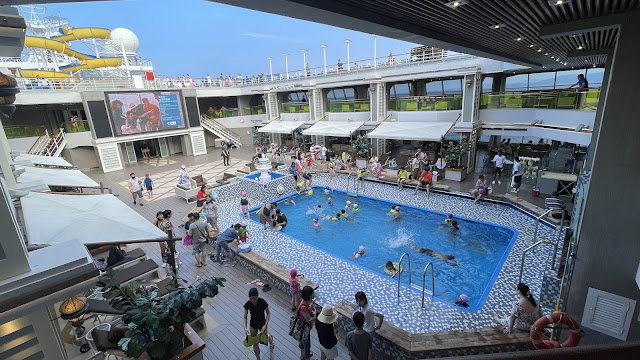Travel Date: 2024/08/11 - 2024/08/14
Instead of the usual flight or ferry, we decided to embark on a less conventional adventure - cruising to Japan. Our journey took us to the vibrant streets of Naha City in Okinawa and the serene beauty of Ishigaki Island. Over the course of three nights and four days, we experienced the unique blend of relaxation and exploration that cruising offers. But as we soon discovered, this mode of travel comes with its own set of surprises.
Join me on a whirlwind 4-day, 3-night cruise to Japan’s serene Okinawa Prefecture, where the reality of just a few hours on land brought both memorable experiences and unique challenges. From the historic Shuri Castle in Okinawa to the tranquil yet limited offerings of Ishigaki Island, I navigated quiet streets, savored fresh sushi, and tackled the quirks of limited time ashore. These posts recount the highlights of our brief land excursions, the nostalgic charm of older taxis, the unexpected challenges of finding food, and the joys of traveling with family. Despite the short visits, each day unfolded with new discoveries that made the journey truly unforgettable.
Okinawa (沖縄本島)
Our cruise to Japan took us to the beautiful Okinawa Island, where we had a brief but memorable visit. Despite the tight schedule, we made the most of our time. Here's a snapshot of our day, including the highlights, challenges, and some practical tips for anyone planning a trip to Okinawa.
Okinawa Island, located in the Ryukyu Islands of Japan, is the largest island in the Ryukyu archipelago. Covering an area of 1,206.98 square kilometers, it stretches approximately 106 kilometers in length and 11 kilometers in width. Situated about 640 kilometers south of Kyushu and 500 kilometers northeast of Taiwan, Okinawa features a humid subtropical climate with lush subtropical forests, notably in the Yanbaru region. The island is known for its rich history, including its role during World War II and its post-war significance as a major U.S. military base. Okinawa is also renowned for its high longevity rates among residents, making it one of the world's "Blue Zones.
Our ship docked at Okinawa Island around 2 PM, but... we didn't step foot on land until about 4 PM. With only a few hours before we had to head back, the pressure was on to make the most of our limited time. Shuri Castle was at the top of our list, followed by a quick shopping trip. The short window of time was frustrating, especially given how much there is to see on the island, but we embraced the adventure.
Getting Around: Taxis
Navigating Okinawa was relatively straightforward, but not without its quirks. We grabbed a taxi from the cruise terminal to Shuri Castle, which cost us 2,300 yen and took about 20-25 minutes. The taxi ride was smooth, and the driver spoke English, which made things easier. After visiting the castle, we quickly found another taxi to continue our exploration. Communication was a bit challenging this time, but giving him phone with Google Maps saved the day and we arrived at our destination. An interesting detail: many of the taxis in Okinawa are older models, which added a nostalgic touch to our journey.
Shuri Castle: A Glimpse into History
Our main destination was Shuri Castle, a site rich in historical significance. Unfortunately, we didn’t realize that the castle had been burned down and is currently being rebuilt. Given this, I wouldn’t recommend paying to enter the paid zone until the reconstruction is complete. Despite this, it was still fascinating to see the site and imagine its former grandeur.
Shuri Castle, once the political, cultural, and religious heart of the Ryukyu Kingdom, stands as a powerful symbol of Okinawa’s rich heritage. Perched on a small hill and encircled by curving walls, the castle was not just a royal residence but also the kingdom's center of governance, where diplomacy and rituals intertwined. Its distinctive architecture, blending Chinese and Japanese influences, reflects the deep historical ties between these cultures.
The castle’s brilliant vermilion color and west-facing structures are unique markers of its grandeur. Despite its destruction during the Battle of Okinawa in 1945, Shuri Castle was restored in 1992 to commemorate the 20th anniversary of Okinawa’s reversion to Japan. The restored castle, modeled after its 18th-century form, now serves as a national park and a vivid reminder of the Ryukyu Kingdom’s legacy.
In 2000, Shuri Castle was recognized as Japan’s 11th UNESCO World Heritage Site, celebrated for its historical and cultural significance. The castle grounds, with their sacred sites and open squares, echo the spiritual and artistic vibrancy that once flourished there. Even after the Ryukyu Kingdom was annexed and the castle repurposed for military and educational use, its essence as the soul of Okinawa remained intact.
On the morning of October 31, 2019, the main courtyard structures of the castle were again destroyed in a fire. Reconstruction is ongoing and is expected to be fully completed by the autumn of 2026. I didn't do much research beforehand and had no idea that the castle was destroyed, but it was interesting to see the restoration in progress.
Continue Reading LINK HERE








%202%20(6).jpg)






















%202%20(5).jpg)




































